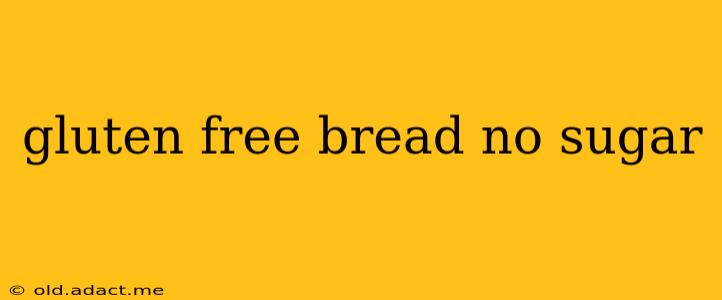Making the switch to a gluten-free lifestyle often involves navigating a minefield of processed foods and hidden sugars. One of the biggest challenges? Finding delicious, sugar-free gluten-free bread. But fear not! This comprehensive guide will explore everything you need to know about crafting and sourcing the perfect sugar-free, gluten-free loaf. We'll tackle common concerns, provide insightful tips, and offer delicious recipe ideas to help you enjoy this healthy bread alternative.
What Makes Gluten-Free Bread Different?
Gluten, a protein found in wheat, barley, and rye, is the key ingredient that gives traditional bread its elasticity and chewy texture. Removing gluten necessitates finding alternative binding agents. This often requires using a blend of gluten-free flours, like almond flour, coconut flour, rice flour, tapioca starch, or potato starch. These flours have different properties, and mastering their combination is crucial for a successful loaf. Furthermore, many commercially available gluten-free breads rely heavily on added sugars to improve taste and texture, which is why making your own, or carefully selecting store-bought options, is essential for a sugar-free diet.
Is Sugar-Free Gluten-Free Bread Healthier?
While the absence of gluten can be beneficial for those with celiac disease or gluten sensitivity, the overall health impact depends on the ingredients used. Sugar-free gluten-free bread can be a healthier choice compared to its sugary counterparts, especially if it's made with whole grains and avoids excessive processed ingredients. However, be wary of nutritional information. Some brands might replace sugar with other sweeteners or utilize unhealthy fats. Always check the ingredients list carefully.
Can I Make Sugar-Free Gluten-Free Bread at Home?
Absolutely! Baking gluten-free bread at home offers greater control over ingredients and allows for customization to suit your dietary needs and preferences. Numerous recipes online cater specifically to sugar-free needs, often using alternative sweeteners like stevia, erythritol, or monk fruit. Mastering the art takes practice, but the reward of a fresh, healthy loaf is worth the effort.
What are the best gluten-free flours for sugar-free bread?
The best flour blend will depend on your desired texture and outcome. Many recipes use a combination to achieve the right balance. Popular choices include:
- Almond Flour: Provides a slightly nutty flavor and adds moisture.
- Coconut Flour: Highly absorbent, so it requires careful measurement and often needs additional liquid.
- Rice Flour: A neutral-flavored option, often used as a base.
- Tapioca Starch: Adds lightness and chewiness.
- Potato Starch: Similar to tapioca starch, contributing to a softer texture.
Experimentation is key to finding the perfect blend for your taste!
What are good substitutes for sugar in gluten-free bread?
Many natural sweeteners can replace sugar without compromising the flavor too significantly:
- Stevia: A natural, zero-calorie sweetener.
- Erythritol: A sugar alcohol with a slightly cooling effect.
- Monk Fruit: Another natural, low-calorie sweetener.
Remember to adjust the amount based on the sweetness level of the chosen sweetener.
How do I avoid common mistakes when baking sugar-free gluten-free bread?
Common pitfalls include:
- Incorrect Flour Ratio: Using too much or too little of any flour can dramatically affect the final product's texture.
- Insufficient Liquid: Gluten-free flours absorb liquid differently than wheat flour.
- Over-Mixing: Overmixing can lead to a tough loaf. Mix only until just combined.
- Incorrect Baking Time and Temperature: Always check the recipe carefully and use a reliable oven thermometer.
Where Can I Buy Sugar-Free Gluten-Free Bread?
Many health food stores and supermarkets now stock a growing range of sugar-free gluten-free bread. However, it is crucial to carefully read the ingredients label to ensure it aligns with your dietary requirements. Look for brands that explicitly state "no added sugar" or clearly list their sweeteners.
Conclusion
Embarking on a sugar-free, gluten-free bread journey can be rewarding. Whether you choose to bake your own or buy pre-made bread, understanding the ingredients and their impact on the final product is key. With a little knowledge and careful selection, you can enjoy delicious and healthy bread that aligns perfectly with your dietary needs. Remember to always check labels and adjust recipes to find your perfect loaf!
